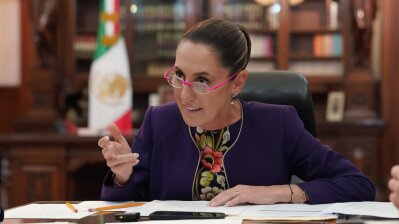Chile lifted its tsunami warning on July 31, nearly 37 hours after an 8.8-magnitude earthquake off Russia's Kamchatka Peninsula prompted the evacuation of approximately 1.5mn people from coastal areas.
The National Service for Disaster Prevention and Response (Senapred) announced that coastal towns across the South American nation were no longer at risk of flooding, allowing evacuees to return to their homes and lifting preventive measures in areas below 30 metres above sea level.
However, authorities maintained their cautious stance, with Senapred director Alicia Cebrián warning that monitoring of Chilean coastal areas would continue due to storm surges recorded in central and southern regions. "The recommendation remains the same: do not approach the coastline; surges can harm people, and we call on citizens to be responsible," she said.
The lengthy alert period, which forced thousands to spend the night of July 30 and early July 31 morning away from their homes, drew criticism from some quarters over the delay in lifting the warning. Technical failures compounded the difficulties, with the Emergency Alert System failing to operate properly on one of the country's telephone networks.
President Gabriel Boric defended his administration's response to the crisis. "It's better to err on the side of caution," he said, later adding: "I am convinced that it is better to err on the side of caution in these cases than to later mourn the death, the destruction of loved ones, or irreparable damage. It is, I insist, learning from our own history."
The evacuation operation, which extended from the northern regions of Arica and Parinacota to Los Lagos in the south, proceeded largely without serious incidents. Easter Island, the first Chilean territory to be affected by the wave train, faced particular challenges in its southern settlements where severe storms brought intense rainfall.
The Hydrographic and Oceanographic Service of the Navy revealed the scale of the tsunami's impact nearly 24 hours after the initial earthquake. Sea levels rose by 2.4 metres in Boyeruca in the southern Maule region, whilst Coquimbo recorded increases of 1.2 metres and Coliumo in Biobío saw rises of one metre.
The disruption was substantial, with classes cancelled, public transport suspended, offices and shopping centres closed, and inmates evacuated from five prisons in high-risk areas.
Chile's response reflects hard-learned lessons from its seismic history. The devastating 1960 Valdivia megathrust earthquake and the February 2010 earthquake in the south-central region have shaped the country's approach to such emergencies. Coastal municipalities are now equipped with evacuation signs, and institutions maintain established protocols for tsunamis generated by earthquakes across the Pacific Ocean.
The president praised both citizens and institutions for their handling of the crisis, highlighting what he described as Chile's civic culture in responding to natural disasters.
Chile's extended alert period contrasted with the swifter responses of other Pacific nations. Mexico cancelled its tsunami warning on July 30 evening after its Navy's Tsunami Warning Center evaluated sea levels along the Mexican coast. The National Civil Protection Coordination stated that "no significant changes are expected to affect the population or maritime-port activities." President Claudia Sheinbaum had earlier reported no damage following the initial warning.
Ecuador also lifted its alert on July 30, with the Oceanographic Institute of the Navy (Inocar) confirming that tsunami waves had passed and no major threat persisted. Whilst wave trains reaching up to 1.3 metres affected the Galápagos Islands and prompted the evacuation of around 1,500 people, authorities concluded that sea level disturbances had "progressively decreased and no longer pose a threat to the population or coastal infrastructure." Maritime activities in the archipelago remained suspended until late evening as a precautionary measure.
News

Mexico's tariff reprieve masks deeper US trade coercion strategy
Mexico secured a 90-day extension from the US, delaying a 30% tariff on its exports. The July 31 deal, reached via a call between Sheinbaum and Trump, marks a tactical pause in rising US trade pressure.
_Cropped_0_1754061582.jpg)
Bosnian Serb leader found guilty in historic court ruling
The verdict raises questions over the country’s future as a unified state nearly three decades after the 1995 Dayton Peace Agreement ended a bloody civil war.

Trump “disgusted” with Russia, as Kyiv strike heightens pressure for new sanctions
US President Donald Trump called Russia’s attacks on Ukraine “disgusting” in his most strongly worded criticism of Russian President Vladimir Putin yet, and warned that Washington will impose new sanctions if no agreement is reached by August 8

El Salvador removes presidential term limits as Bukele tightens grip on power
El Salvador's legislature has approved constitutional reforms that will allow President Nayib Bukele to seek indefinite re-election, marking the latest step in what critics describe as the Central American nation's slide towards autocracy.



